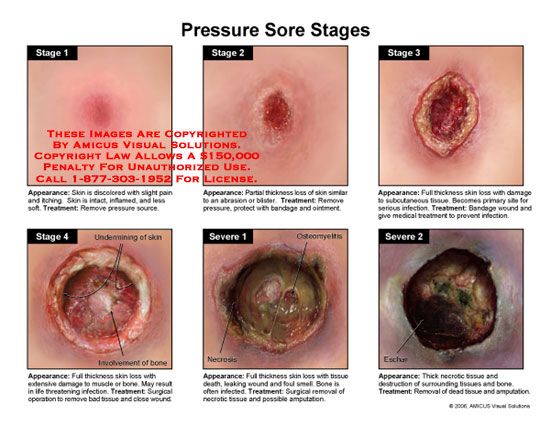Prevention of bedsores for bedridden patients at home
Bedridden is the physical status of the patient that he will be lying in the bed all
the time causing damage to his skin and causing bedsores.
Bedsore: damages to the skin and tissue resulting from pressure on the skin for a long time.
The
home care of the bedridden is important because it:
Makes
them full clean, enthusiastic, fresh, and happy and gives them comfort.
It
helps in improving the health conditions of the patients
.
Structure
of the skin :
The skin has three layers. The outer, middle, and
inner layer.
1. The outer layer of skin,
provides a barrier that prevents the entry of any harmful elements into the body.
- The middle layer contains hair follicles and sweat glands that moisten the skin
- The inner layer is made of fat and connective tissue that gives shape to the organs
The function of the skin :
1. Protection: protection from pathogens
entry into the body
2. Sensation: contains nerve endings
that give heat and cold feelings.
3. Storage: acts as a storage for fats and
water
4. Water barrier: The skin acts as a barrier
for nutrients so they do not get washed out of the body.
The causes of bedsores are:
- Lack of skincare
- Bed linen not changed
- Dirty bed linen
- Prolonged bed rest
- Lack of movement
- Lack of good diet
Early signs of bedsores are:
- Changes in
skin color or texture
- Scratching
of the skin
- Swelling
of the part
- Part
becomes warmer to touch than other areas
- Skin becomes tender and painful
5.
Prevention of bedsores:
Skincare:
1. Back care:
• Keeps skin clean and dry:
• Cleaning and drying help in
preventing the development of bedsores
Changing the position of the patient:
• Change positions 2 hourly
• When you change a patient’s positions,
there will be less pressure on the patient’s skin which will reduce his/her risk of
developing bedsores.
• You can give two positions in
lateral, right, and left and supine positions to the patient with the help of
pillows.
Range of motion exercises:
Give a range of motion exercises to the patient in bed that can help in reducing the
risk of bedsores and increase circulation.
While
giving exercises to the bedridden patient, caregivers need to carefully assess the body position of the patient and support the part that will be exercised.
Diet for the elderly :
‘Dos’ and Don’t to be followed for providing
diet to the bedridden patient.
Does:
1- Give diet as per physician’s
recommendations.
2- Give diet based on his/her likes or dislikes
3- Provide warm food
4- After food rinse, his/her mouth
properly
5- If the person is with tube feed, give
feeding as prescribed by the physician.
6- For tube feeding, check the tube’s
position before starting to feed
7- After tube feeding rinse the tube with
water
8- Give propped up or sitting position to
the patient in bed before serving food.
9- The diet should be with more green
vegetables, fibers, and fruits to reduce constipation and give the body vitamins and
minerals needed.
10- Include in the diet fish & chicken
(protein) as it will help in improving the skin, healing the wound, and immunity
function.
11- Provide more water that is good for
hydration and skin health.
Don’ts
:
1. Do not give forced feeding
2. Do not feed hurriedly to the patient,
let him/her chew the food adequately
3. Do not instill air while giving tube
feeding
4. Do not feed when the patient is lying down
or sleeping
5. Do not spill the food particles on the bed



